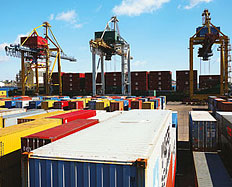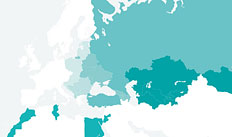COUNTRY ASSESSMENTS
Egypt
HIGHLIGHTS OF THE PAST YEAR
- Macroeconomic fundamentals have notably deteriorated during the lengthy political transition period. The significant capital outflows and plummeting of tourist receipts have led to a precarious external position, with reserves reaching dangerously low levels. The authorities formally requested a US$ 4.8 billion loan from the IMF in August 2012.
- Investors adopted a wait-and-see approach, especially due to continued uncertainty with regards to the political transition. This has delayed the resumption of capital flows and FDI into the country. Following presidential elections, however, business sentiment may be turning more positive.
- Structural reforms have not gathered much pace in light of the political transition under way. Interim governments since the overthrow of the previous regime have not been able to implement substantial reforms, and delays are expected in the implementation of many key reforms under way.
KEY PRIORITIES FOR 2013
- The key immediate challenges are to restore macroeconomic stability and achieve job-creating growth. Structural skill mismatches and a lack of employment opportunities, especially among the youth, are chronic problems. A combination of restrictive labour market regulations and the lack of adequate training opportunities have led to persistent skill mismatches in the labour market.
- Subsidies are a substantial burden on the budget and should be better targeted. Subsidisation of many sectors – including food, energy, and utilities – constitutes more than a quarter of total public spending and distorts incentives across most sectors.
- Strengthening the regulatory framework is required to ensure a level playing field for private business. The state’s role as regulator and competition enforcer is very weak. Egypt’s judicial capacity is limited and state involvement is pervasive in many aspects of business.
MACROECONOMIC PERFORMANCE
The economy faced significant headwinds throughout the year. Real GDP growth reached 2.2 per cent at the end of the 2011-12 fiscal year (which runs from July to June), down from an average growth rate of 5 per cent in the past decade. The recent economic performance falls well below the estimated growth rate of 6-7 per cent required for Egypt to keep the unemployment rate unchanged. While tourism, mining, manufacturing and construction have somewhat recovered throughout the fiscal year, this is mostly due to favourable base effects associated with a near-stagnation of economic activity following the uprising, and they still remain significantly below levels seen in 2010. A more pronounced economic downturn was, however, avoided by buoyant private consumption. The unemployment rate has increased throughout the year, from 8.9 per cent in 2010 to 12.6 per cent by end-June 2012.
Egypt’s balance of payments remains under significant pressure, mostly due to continued capital flight and falling tourist receipts. The current account deficit reached US$ 7.9 billion (3.2 per cent of GDP, up from 2.2 per cent the previous year) due to weak export growth and higher energy import costs. Tourist receipts fell by 11 per cent throughout the year. Further deterioration was, however, avoided by strong remittance inflows. In addition, the financial account remained weak, as FDI declined by 5 per cent during the year, coupled with a near doubling of portfolio outflows, especially as foreigners shed their treasury-bill holdings. Meanwhile, official foreign reserves reached US$ 15.1 billion in August covering just over three months of imports.
Weak economic activity and higher government spending on social benefits and subsidies have increased pressures on the fiscal front. The general government’s fiscal deficit widened from 10 per cent of GDP in FY2010-11 to 11 per cent in FY 2011-12, surpassing the government’s forecast of 8.6 per cent of GDP. Expenditures increased by 17 per cent, due to hikes in wages, social benefits and fuel subsidies, while borrowing costs continued rising. Subsidy spending rose by 23 per cent on the previous fiscal year, with petroleum subsidies constituting more than a fifth of total expenditure. In September 2012 the government provided details of a new pricing structure to reduce the burden of fuel subsidies on the budget by US$ 4.2 billion (around 2 per cent of GDP) and has been consulting with civil society to build consensus. However, the higher government spending has been to the detriment of public investment, which has fallen by 14 per cent over the fiscal year. While external debt has not increased significantly, the government has instead resorted to borrowing heavily and at a high cost from domestic banks, increasing the sector’s exposure to sovereign credit risk and crowding out private credit.
There are significant downside risks to the outlook associated with continued uncertainty. Egypt formally requested a US$ 4.8 billion loan from the IMF in August 2012, to financially support the government’s economic reform programme, and to ease the country’s deteriorating external and fiscal positions and boost investor confidence. The loan is likely to be conditional on major food and fuel subsidy reform, and will seek to attract other funds into the country. Consumer confidence has also been on a downward trend during the first half of the year, reaching lows seen during the most acute periods of the political turmoil in 2011, but business sentiment has picked up after the presidential elections in June 2012.
MAJOR STRUCTURAL REFORM DEVELOPMENTS
Egypt adopted several structural reform programmes over the past two decades with mixed results. The reforms included privatisation of state-owned enterprises, financial sector reforms, tariff reductions, capital account liberalisation, improvements in the business environment (for example, enhancing conditions for start-ups and creating a competition agency) and fiscal-structural reform (for example, income and corporate tax reforms and modernisation of tax administration). Although these reforms helped to bring about successful external liberalisation and a reduction in most trade and investment barriers, they did not manage to structurally reduce high unemployment rates or spread the reform benefits to large segments of the population.
The structural reform gaps in Egypt remain large and key market distortions persist. The state’s role as regulator, guarantor of competition and enforcer of contracts has tended to be weak. In many sectors, regulatory functions are not fully separated from state operations. The Egyptian Competition Authority is not fully independent and the extent of its enforcement authority and mechanisms is unclear. In addition, Egypt’s judicial capacity is weak and state involvement in many aspects of business remains heavy, leading to the lack of a level playing field for private businesses. Judicial procedures tend to be lengthy, costly and subject to political pressure and bureaucracy. Egypt ranked 110th (out of 183 countries) for ease of doing business in the 2012 World Bank Doing Business Report, below its SEMED peers and the regional average for the Middle East.
A number of reforms are still lagging in the agribusiness sector. Subsidies, export bans, and continued state ownership and dominance are prevalent in this sector. The agribusiness sector also lacks streamlined regulation to ease the process of owning and leasing agricultural land and reforms have yet to be developed which address the lack of alternative sources of collateral such as warehouse receipts, especially in light of severely constrained access to finance from banks.
Key challenges exist in upgrading and decentralising the municipal infrastructure sector. Municipal services in Egypt are in urgent need of investment to provide better access and improved quality. Among the top priority areas are inadequate solid waste management and urban traffic management. Non-sovereign financing is limited, but decentralised financing solutions are being developed to move towards improved cost recovery and commercial discipline.
Egypt has yet to undertake substantial reforms in the energy sector. The current energy subsidy system places a heavy burden on the fiscal account and provides distorted incentives for energy use and energy efficiency. Reforms are still needed to unbundle and fully commercialise the energy sector. The authorities have expressed their intention to introduce public-private partnership (PPP) schemes that would expand private sector involvement, but concrete legislative action has yet to materialise. In addition, reforms are needed to provide incentives for investment in cleaner conventional and alternative fuels, in order for Egypt to both exploit its resources, notably in wind and solar, and alleviate pressure on domestic natural gas production.
The regulatory frameworks in the transport and power sectors have not been sufficiently upgraded. These large infrastructure sectors continue to be dominated by state-owned enterprises with significant involvement and control by the central state authorities. In addition, Egypt has yet to reduce the high levels of subsidies for power, fuel and transport fares which keep prices for public services substantially below cost-recovery levels. In 2012 the Egyptian government announced plans to decrease fuel subsidies by 27 per cent. The authorities expect complete elimination of subsidies to be achieved by 2018, according to the latest announcements. Extensive regulation and the absence of market-based mechanisms for the pricing and delivery of services are also partly responsible for inefficiencies in public sector entities.
The financial sector is relatively well developed, but access to credit is limited. Improving access to finance for micro, small and medium-sized enterprises (MSMEs) is one of the key reform challenges in the financial sector. Poorly developed credit bureaus and weak contract enforcement are among the key obstacles to the further development of MSME finance. Since 2010 access to credit information has improved slightly with the addition of retailers to a private credit bureau database. However, credit to the private sector continues to be squeezed out by the government, and banks tend to favour lending to large, established companies. In addition, an unfinished privatisation agenda in the bank and non-bank financial sectors has left a number of institutions under state control.







